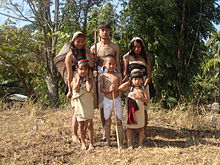Biate people
The Biates are an ethnic hill tribe of Assam, Meghalaya, Mizoram, Tripura and Manipur.
[1] Spread over many parts of North-East India, they have a unique identity with a rich and distinctive history, culture, dialect and religious heritages.
[3] According to legends, while they were in Saitual, a group of people known as the Koilam or Kawilam from Rulchawm village of Mizoram (India) used to sacrifice human to appease a large python called Rulpui, believing that the snake had supernatural power.
Thus, some writers are of the opinion that the word Biate originates from the term Rul-Bia-Te or Rul-Biak-Te, which means snake-worshippers in other dialects.
Tracing back through orally histories, the Biate tribe with its cognate clans may have started a migration from China between 206 BC and 202 BC—between the fall of the Qin Shi Huang's kingdom and the emergence of the Han dynasty.
Their migration, according to L. H. Songate, was due to acute oppression and maltreatment in the construction of that great wall or fortress by a cruel king Shi-Huang.
[7] The tribes then proceeded towards south met stiff resistance when they began to settle in the bordering area of Burma and China.
They are also believed to have settled in the area of Mengban, Lancang, Menglian and Menghai for some time in the bygone days.
[3] C. A. Soppitt has accounted that the tribe had already reached Burma previous to the introduction of Buddhist doctrines, that is to say, in the 8th or 10th century.
According to P.M.Gangte the Mizo tribes (Old Kuki) has already occupied the present Chin Hills before the end of the 8th century AD.
[7] The Khawthlang or Thlangfa tribes (Westerner) as considered by J. Shakespeare, were the Old Kukis, the Biate (Beteh) and other cognate clans.
[9] In the early days of their settlement in Mizoram, the Khawthlang tribes were ruled by the Biate king Vannuailala, son of Tengtonga Khoreng, who gave himself the title of ‘Chonpuimang’ (Chonmang in the account of Songate, L.H.).
Pakem, also wrote that these round stones and hollow ground resemble those found in the nearby Sumer Elaka, between Umkyurpong and Kseh villages in Meghalaya.
[14] The second migration of the Biate tribe from Mizoram and nearby hills of Tripura took place between 1500 and 1600 AD.
The night of the wedding, the groom's family pays the bride price to the girl parents, around INR 185.00, and a bronze or copper plate called Mairang.
According to tradition, the groom stays for seven years for 'Mak-sin' or 'in-law's duty' in his father-in-law's house, to assist them and develop a good relationship with his new family.
[16] Historically, the Biate tribe practiced animism, but they also strongly believed in a supreme being called Chung Pathian—which means the God above.
Other primal gods and goddesses were Bolong Raja or Tarpa, Theisini Kara, Khua Vuai, Dangdo, Fapite, Sangkuru, Truanpuia etc.
Robert Evan and the Khasi missionary Mr. Khulu Malang the Biate embraced Christianity in the year 1890.
[17] Like all other hill tribes of North East India, the Biates have their own cloth making system since time immemorial.
Among the Chin-Kuki-Mizo group, the Biates, Hrangkhols and Sakacheps (Khelma) are the only tribes who practice weaving silk clothing since time immemorial.

